What to Do When Encountering a Rattlesnake While Hiking
Found throughout both North and South America, rattlesnakes, just like cougars, are some of the most feared creatures by many hikers.
In the contiguous United States, they’re extremely abundant and live in every region, from New England to the Southwest, from the Pacific Northwest to the Deep South.
You may encounter a rattlesnake in numerous different national parks, including Shenandoah National Park in the East, Badlands National Park in the Midwest, and Joshua Tree National Park and Saguaro National Park in the Southwest.
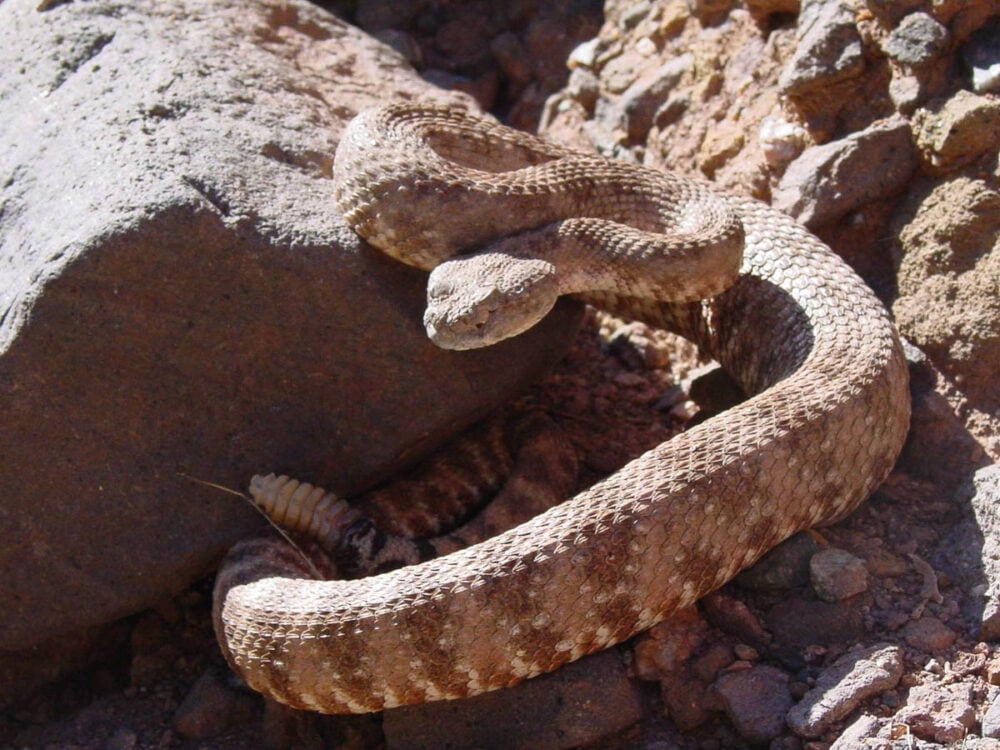
This what to do during a rattlesnake encounter post contains affiliate links. You can read more about our Terms of Use / Disclosure here.
The largest concentration of rattlesnakes in the U.S. is in the Southwest—Arizona and Texas are home to the highest number of rattlesnake species.
Although they’re very common and venomous, it’s important to realize that they’re not aggressive. It’s okay—normal even—to be afraid of rattlesnakes, but there’s absolutely no reason for panic or hysteria when hiking in rattlesnake territory.
Common sense and adherence to the rattlesnake encounter safety tips in this post are all you need.
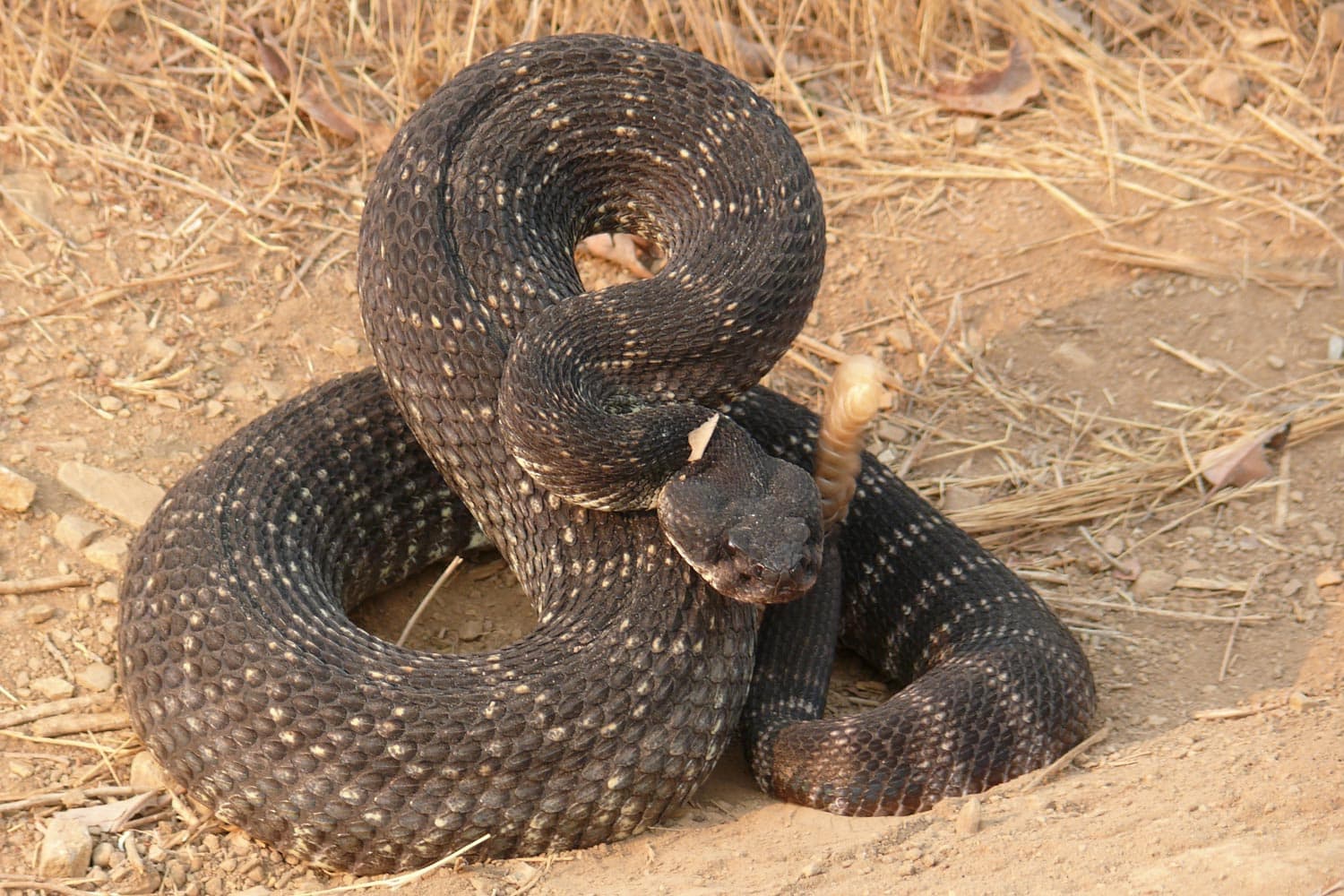
Hiking and Rattlesnake Safety Tips
Unlike some venomous snakes in places like Australia, rattlesnakes are quite shy. They don’t chase people. In fact, they like being noticed about as much as you enjoy encountering a rattlesnake while hiking.
Rattlesnakes are only aggressive toward their prey, which includes rats and mice, small birds and lizards.
- A rattlesnake’s first line of defense is staying motionless—their camouflage helps greatly with not being detected.
- Second, it’ll move to safer areas if it has the chance to do so.
- If cornered or surprised, the third thing a rattlesnake will do is rattle its tail. This alerts the potential threat of the snake’s presence.
- The absolute last step a rattlesnake takes when a threat gets too close is strike.
Remember that they will only strike when startled, provoked or threatened. In addition to the characteristic rattling, rattlesnakes actually also hiss when threatened, which sounds a lot like a hissing cat.
A rattlesnake strike typically only happens when people actually touch the snake, or are about to touch it. The majority of rattlesnake bites occur on ankles, feet and hands.
Note that, since these strikes are strictly defensive in nature, about a quarter to half of rattlesnake bites are “dry” bites. This means there’s no venom involved. They can be very painful, though.
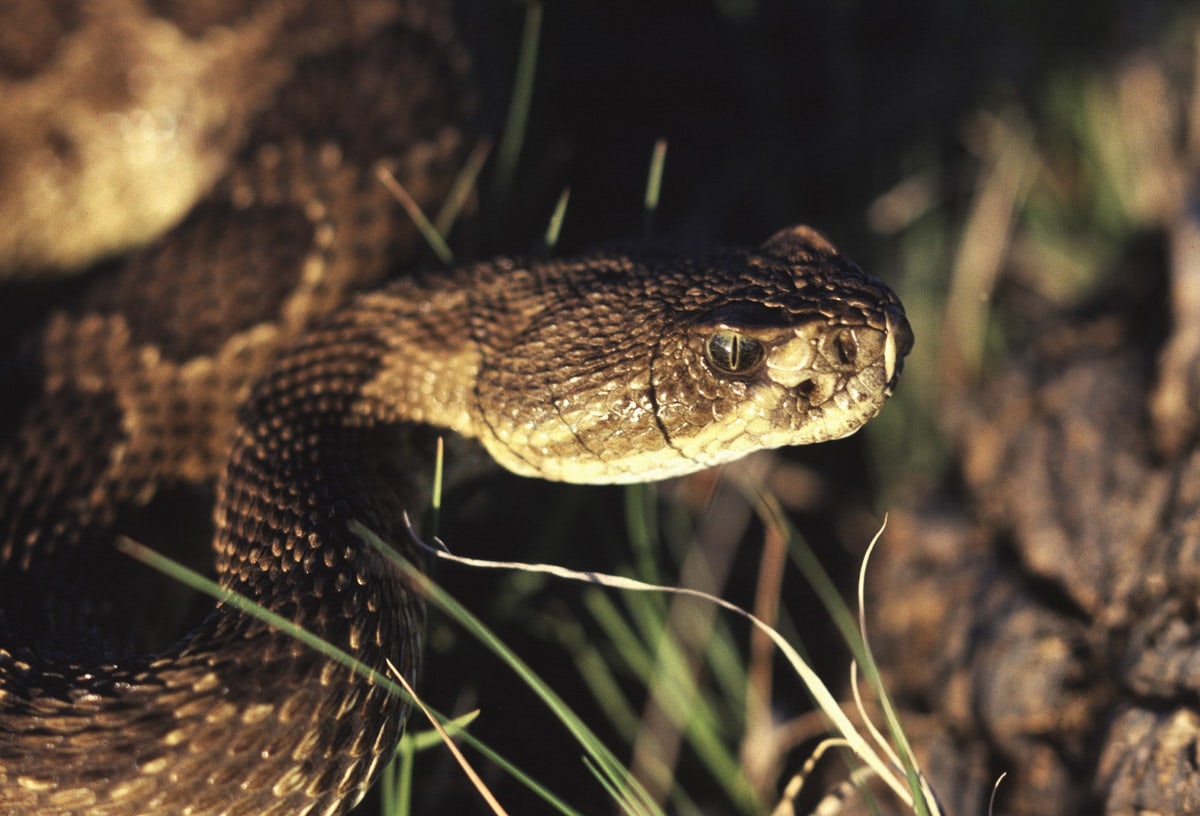
Recognizing a Rattlesnake
If your hike will take you into snake country, it’s smart to make sure you know how to recognize a rattlesnake.
A snake encounter could involve both non-venomous and venomous snakes. In the U.S., there are four types of venomous snakes: copperheads, water moccasins, coral snakes and rattlesnakes.
There are more than 25 known species of rattlesnake in the U.S., the most common of which are timber rattlesnakes, prairie rattlesnakes, eastern and western diamondback rattlesnakes, and speckled rattlesnakes.
Additionally, they are many dozens of subspecies. They range in length from 1 to 8 feet (30 to 240 centimeters). Most adult rattlesnakes are somewhere in the middle of that, though.
While each (sub)species has its own distinct features, there are a few general characteristics by which you can recognize a rattlesnake.
- Broad, flat and triangular-shaped head that’s narrower at the tip than at the base.
- Body that appears heavy, thick or fat.
- Hooded eyes with vertical, elliptical, cat-like pupils.
- Keeled scales in a variety of patterns and colors (depending on the species). Most species have dark patterns of hexagons, diamonds or rhombuses on a light, tan or brown background.
- Openings between the eyes and the nostrils. These are the heat-sensing “pits”.
- Blunt tail with the characteristic rattle.
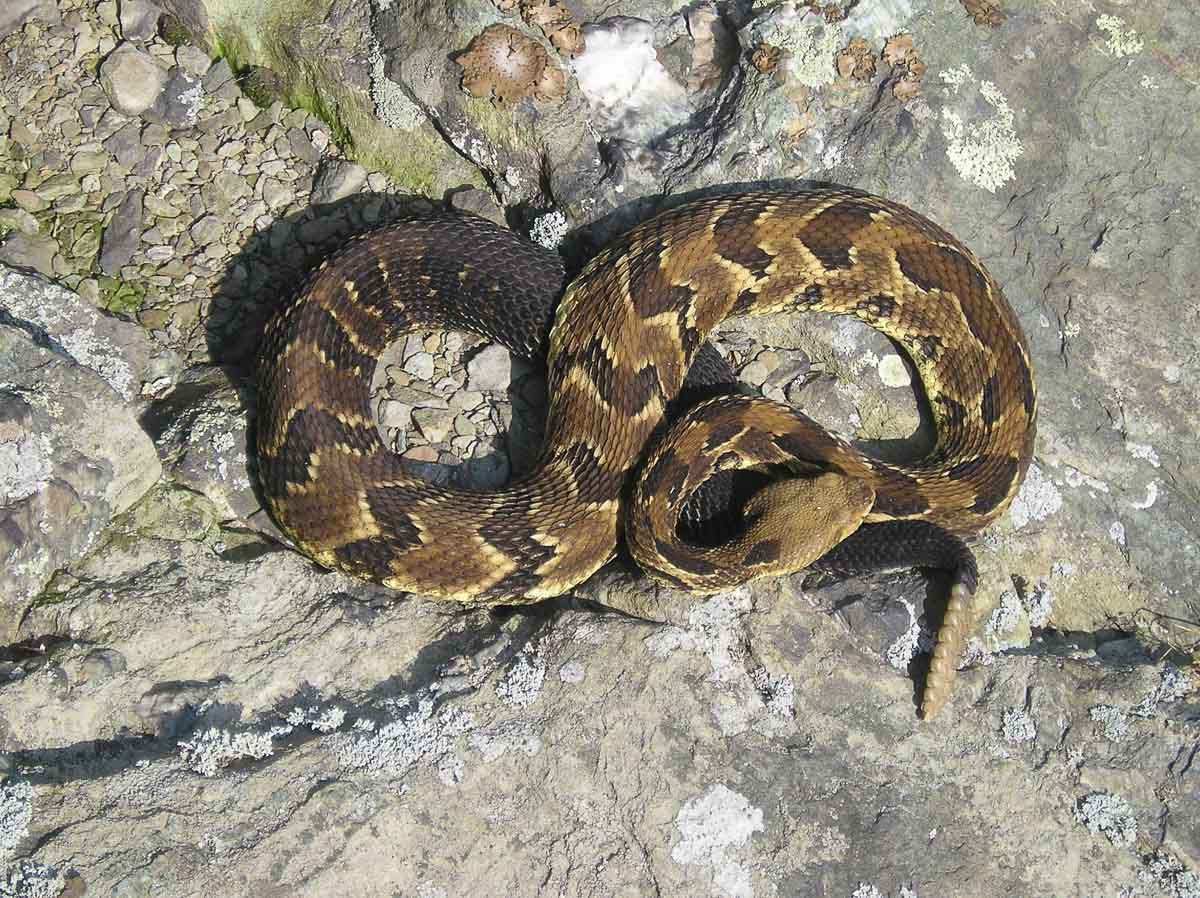
How to Avoid a Rattlesnake Encounter While Hiking
There are a few actionable things you can do to avoid rattlesnake encounters while hiking. Once you’re in rattlesnake territory, an encounter is basically always coincidental.
To minimize your chances of seeing a rattlesnake on the trail, here are ten effective rattlesnake safety tips and precautions you should keep in mind.
- Inform yourself about when and where you’re most likely to encounter a rattlesnake. (See the FAQs at the end of this post.)
- Check trip reports and pay attention to warning signs. They’re there for a reason.
- Hike with trekking poles. Use them to push away vegetation that extends over the trail, as well as tap rocks where rattlesnakes may be hiding.
- Hike on popular, well-trodden trails. Stay on those trails.
- Don’t walk in thick brush, dense vegetation or tall grass.
- Stay together, keep children close and dogs on a leash.
- Don’t step or put your hands in places you can’t see. Step on logs or rocks first, instead of directly over them.
- Don’t move or pick up branches or rocks while hiking. Be especially careful when gathering firewood.
- Occasionally stomp your feet on the ground. Snakes are very sensitive to vibrations.
- Wear ankle-high hiking boots, loose pants and thick socks. You might also want to wear snake gaiters for extra protection and peace of mind.
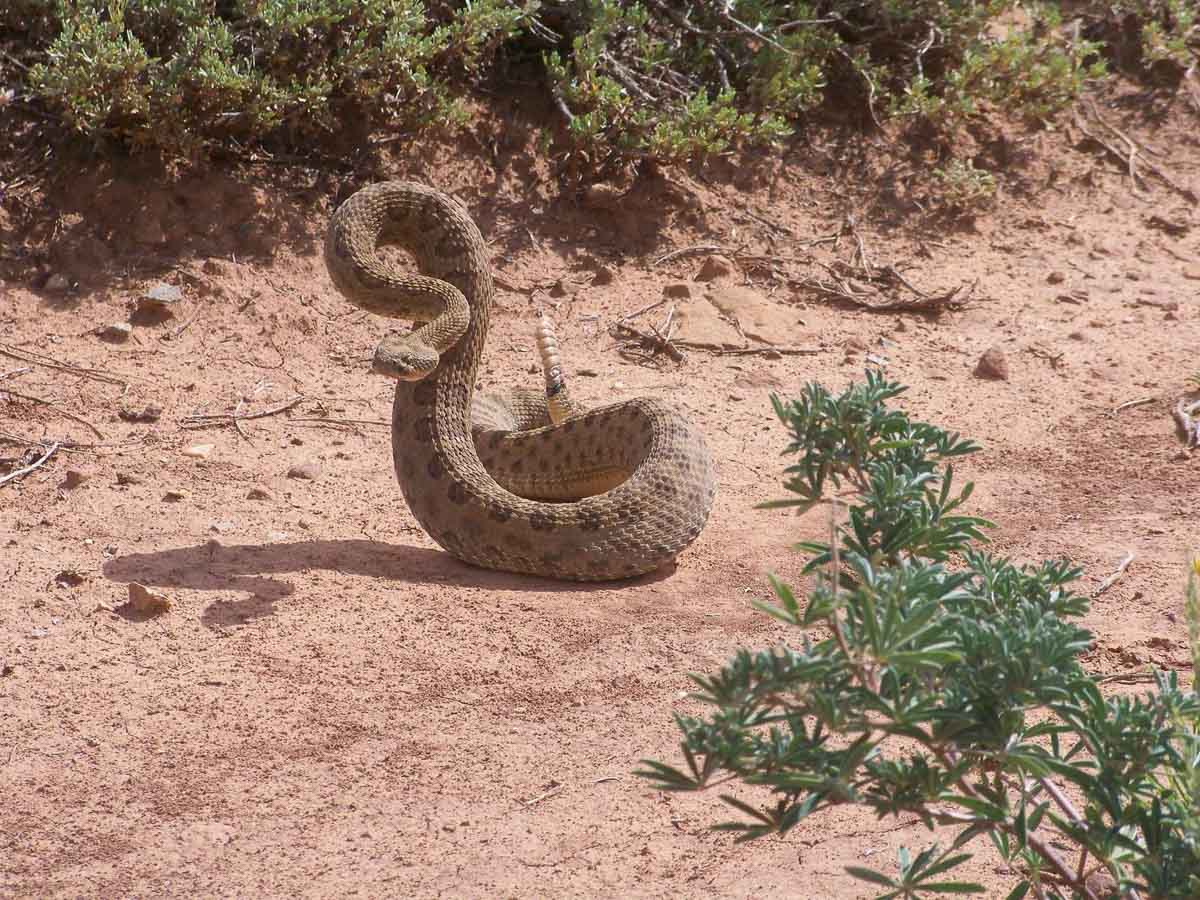
What to Do If You See a Rattlesnake On the Trail
Even if you know how to avoid rattlesnakes, you can never completely eliminate the chance of encountering one. Sometimes, there’s simply no way to spot a snake under a rock or brush, or around a corner.
If you do happen upon one or hear a rattle nearby, this is what to do in case of a rattlesnake encounter when hiking.
- Don’t move. Evaluate the situation.
- Figure out where the rattling is coming from. If you can’t see the snake, try to find the location or at least general direction of the sound. This is absolutely essential. You don’t want to accidentally move toward the snake and make it feel threatened even more.
- Slowly back away. When you know where the snake is, slowly and quietly move away. Don’t make any sudden movements that may trigger a strike. Keep your trekking poles (see above) between yourself and the snake. In case of a strike, the snake might choose a pole over your leg.
- Never provoke the rattlesnake. Leave the snake alone! Do not approach it, poke it or throw rocks at it. A bite from an angry rattlesnake might have more venom in it than one from a snake striking in self-defense.
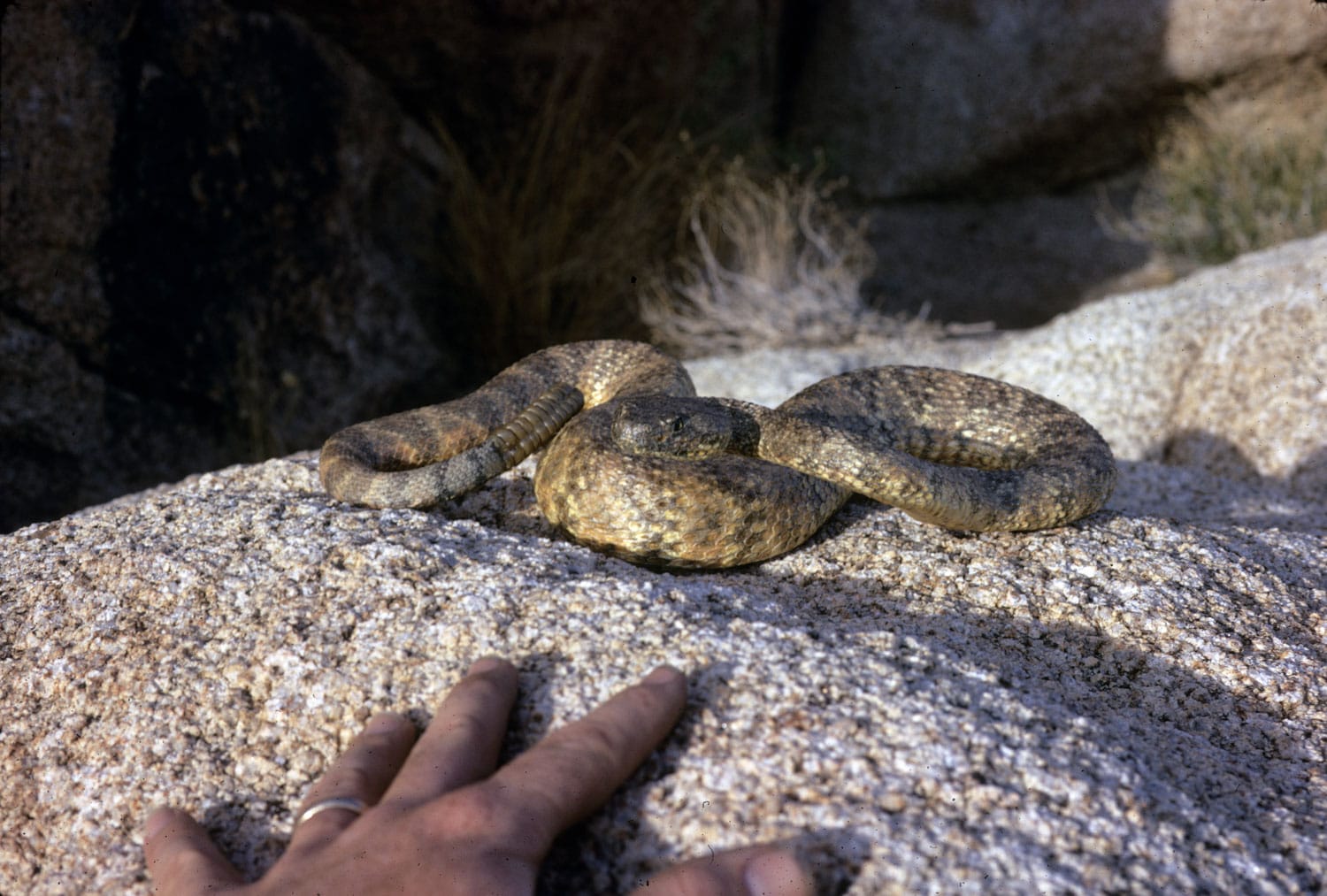
Note: This is an image by the National Park Service to demonstrate what ABSOLUTELY NOT to do during a rattlesnake encounter. (This is a stuffed rattlesnake.)
What to Do If Bitten by a Rattlesnake
If you have the misfortune of being bitten by a rattlesnake while hiking, there are a number of things you should and should not do.
This is a serious situation and you really don’t want to make things worse by being misinformed—or worse, not informed at all.
Do
- Stay calm! This is the most important thing to do after a rattlesnake bite while hiking. Don’t move too much. Snake venom spreads slowly throughout the human body. Try to keep your heart rate down to prevent the venom from spreading faster.
- Wash the bite area with water and soap, if possible. Make sure you take a first-aid kit when hiking!
- Immobilize the bite area.
- Remove things like rings, watches and tight clothing to allow swelling to happen.
- Keep the bite area below the heart to reduce circulation.
- Call 911 from the trail. If you’re hiking with someone else, send them back to the trailhead to get help. In case you’re alone (which is not advisable), walk back slowly and try not to exert yourself. If your dog or child is bitten by a rattlesnake, carry it back in your arms.
- Get to the nearest hospital or medical facility as quickly as possible.
Don’t
- Don’t cut into or near the bite wound.
- Don’t put ice on the wound.
- Don’t restrict blood flow with a tourniquet, bandages or other constrictions.
- Never try to suck out the venom with your mouth. Rattlesnake venom can also enter the bloodstream via tiny wounds in your mouth, or you might even swallow some of it.
While a rattlesnake bite while hiking is a stressful situation, it’s also important to know that only about 1 in 600 bites are fatal.
Deaths from a rattlesnake bite are extremely rare, also because 25 to 50 percent of all rattlesnake bites don’t involve the injection of venom at all. Either way, if bitten, you should always assume that there’s venom involved and seek medical help.
Camping in Rattlesnake Country
You now know what to do if you encounter a rattlesnake while hiking. But what about camping? As fun as camping is, it’s an activity that demands care and attention, particularly if you’re in wilderness areas.
Make sure you what to do when you’re in grizzly bear and black bear country, but definitely also take some precautions if there are rattlesnakes around.
- Arrive at your campsite during the day. Set up camp while it’s still light out. Don’t pitch your tent in the dark.
- Always keep your tent zipped. At all times. Even when you’re cooking or hanging out near your tent.
- Check your tent before going to bed. Shake out your sleeping bag every time before you hop inside.
- Be careful when collecting firewood.
- Always use a flashlight or headlamp when walking around in the dark.
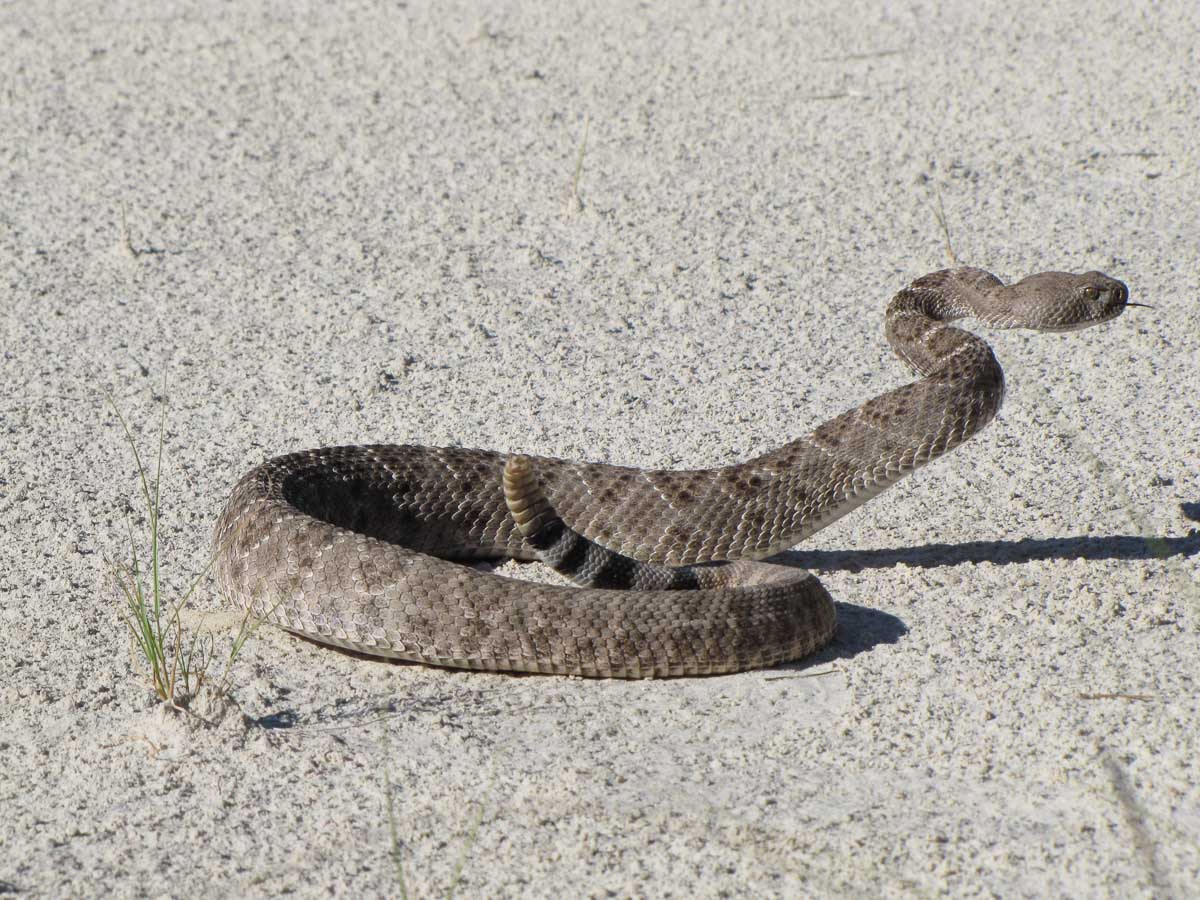
FAQs About Rattlesnakes
What Time of Day Are Rattlesnakes Most Active?
If you want to avoid encountering snakes while hiking, the best time of the day for a hike varies by season and location. In general, rattlesnakes are most active in temperatures between 70 and 90 degrees Fahrenheit (21 to 32 degrees Celsius). This is their optimal basking range.
Therefore, it’s impossible to say exactly when rattlesnakes are most active during the day. That simply depends on the day itself: where you’re hiking, the season and the weather.
Are Rattlesnakes Active at Night?
Absolutely. It’s a myth that rattlesnakes sleep at night. Many rattlesnake species are nocturnal during summer, avoiding the heat during the day.
You’re much more likely to encounter a rattlesnake at night in hot desert areas than in humid and temperate areas. In spring or fall, rattlesnakes tend to be more active during the day.
How Far Can a Rattlesnake Strike?
The rattlesnake striking distance depends on the length of the snake, whether it’s coiled or not, the species and its body temperature.
At most, a rattlesnake can strike up to two-thirds of its entire body length from a coiled position. So, a three-foot snake may be able to reach as far as two feet.
Usually, however, there’s no time to assess the animal’s exact body length during a rattlesnake encounter. Always assume you’re within striking distance and back away.
Additionally, remember that a rattlesnake doesn’t need to be coiled to bite. It can bite from basically any position, albeit not as far.
Can Rattlesnakes Swim?
Yes, rattlesnakes are actually pretty good swimmers. They’ll enter water for a variety of reasons, from pursuing prey to escaping threats. Be careful around water in rattlesnake country. What looks like a stick might actually be a snake.
How Fast Can a Rattlesnake Move?
Contrary to popular belief, rattlesnakes aren’t all that fast. Although there aren’t (m)any specific studies about the speed of rattlesnakes, it’s understood they generally travel between 2 and 3 miles per hour (3 and 5 kilometers per hour). That’s basically the average walking speed of a person.
So, if you’re worried about being chased by a rattlesnake, don’t be. One, they’re not aggressive and don’t follow people (only prey)—and two, even a child could easily outrun a rattlesnake.
Can Rattlesnakes Kill You?
Short answer: yes, rattlesnakes can potentially kill you. Longer answer: it’s very unlikely to die from a rattlesnake bite.
I’ve mentioned a couple of times that many rattlesnake bites are “dry” and don’t contain any venom. Even if venom is injected, though, getting medical attention in a timely manner will almost always save the victim.
Although rattlesnake venom is extremely potent, administering an antivenin and additional professional treatment are usually sufficient to eliminate all unfortunate consequences.
According to the U.S. Forest Service, merely 1 out of every 600 rattlesnake bites is fatal. It’s also good to note that many fatal rattlesnake bites are due to the person going in shock, not to the actual venom. This is why it’s so critical to stay calm and composed in case you’re bitten.
What Do Rattlesnakes Eat?
The typical prey of rattlesnakes includes rats and mice, small birds and lizards.
Do Rattlesnakes Hibernate?
Technically, no. Rattlesnakes don’t hibernate, but some species do enter a period of so-called brumation in winter.
During this time of dormancy and decreased activity, rattlesnakes often gather in “rattlesnake dens” in large numbers. However, on warm winter days, you might still encounter a rattlesnake on the trail, soaking up as much sun as it can.
Additionally, in hot regions, rattlesnakes can also enter a state of dormancy in summer, during hot and dry periods. The technical name for this dormancy is aestivation.







About 10 years ago I was hiking a trail to Jensen Ledges, near Long Eddy, NY. I was accompanied by my brother and my (leashed) dog. There are cliffs and rocky outcroppings, some of which I have rappelled. While focused on the ledges above us and not the trail ahead of us we were greeted with the rattle of a coiled snake. We jumped back immediately and I pulled my dog with me. Both my dog and I were close enough for the snake to have struck us, but the snake chose not to do it. I did have to use a long stick to move the snake off the trail so we could safely pass. The incident ended well. Nobody bit and no snake needlessly killed.
my dad was killed by a diamondback rattlesnake last year. it never rattled it’s tail. he has been working out on our property in the TX hill country for decades and has a plenty of experience being in areas where rattlesnakes are present. not all rattlesnakes will warn before they strike.
I’m so sorry to hear that, Adrian. Sometimes encounters are so unfortunate that neither the person or the snake has time to respond, send a warning or get away.
After reading about mountain lions, bears, and venomous snAkes, I am happy to stay in the lodge and knit!
Nothing wrong with enjoying some time in a cozy lodge! I’m all for it.
040323 Dear Bram — We are writing to request permission to use the photo of a coiled rattlesnake on your page above the Recognizing a Rattlesnake headline to help to illustrate the article about Sequoia and Kings Canyon National Parks Trail Crews on our totally non-commercial, non-profit, all-volunteer, public-interest website, http://www.tularecountytreasures.org. Our mission is to celebrate, educate, and inspire by sharing the stories of the wonderfully diverse places in our county that have been conserved, and of the dedicated people who have worked to protect and steward them. If we may use this photo, please let us know how the credit should read. Thank you for your prompt response, and for your informative and well-illustrated website.
— Laurie S./for TCT Project Team, 559-561-0111
Hello Laurie! Thanks for reaching out. After reviewing the images in this post, we decided to replace several of them with public domain photos from the National Park Service. You can find numerous copyright-free images of rattlesnakes on this NPS resource website: https://npgallery.nps.gov/. I hope this helps!